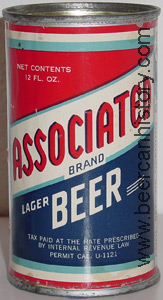
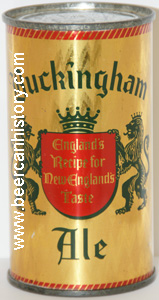
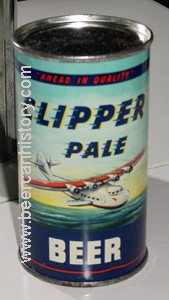
 |
 |
 |
| A is for Acme Brewing of San Francisco and Los Angeles: (Sept/2011) In Calif. and adjacent states, if a 1930's to late 1940's era beer can happens to be found, among the most commonly seen would be an Acme Beer - the red/black can from the 1930's or the black can used into the 1950's. A few Acme cans are moderately scarce when found on- grade - the two Ale variations produced in the 1930's, and the bock can with the "shield" label, produced in the early 1950's. | |
Acme Brewing, with its two plants combined, made it the largest brewing company in Calif. in the 1930's. However, after WWII, its market share dropped steadily as Lucky, Burgermeister, Regal, and Maier increased their market shares temporarily until the early 1950's. Then starting in the mid 1950's, outside-California brewers Coors, Olympia, Budweiser, Hamm, and Schlitz began capturing market share from most other sellers. Acme Brewing Company ended in 1954, selling the Los Angeles plant to Rheingold of New York. By the late 1960's, Coors had become the leader in California beer sales with around 25% of the market; together with Olympia, Budweiser, and Schlitz, the four brewers had over 65%. The only remaining California brewers that canned beer were Lucky and Maier with a 10%, and declining, market share. |
|
 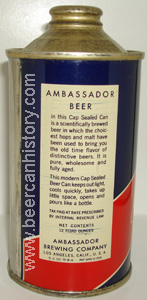 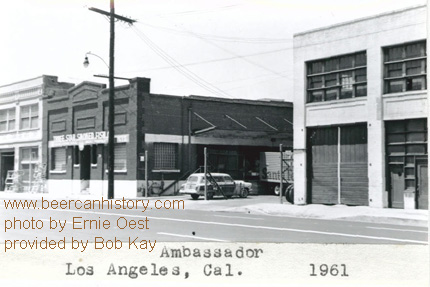 |
A is for Ambassador: (Sept/2011) Dan Andrews wrote an article in BCCA magazine on this small Los Angeles brewery that operated until around 1941, producing only one can label and apparently very little breweriana. Per Calif. Brewing Assn. records, after ranking #14 in beer sales for 1935 among 35 Calif. breweries, Ambassador dropped steadily in the following years during the time when it was canning beer. By Dec. 1937 the brewery had dropped down to 22nd and had annual taxable beer sales only ahead of Globe and Salinas (Monterey brand). Among the on-grade examples known for Ambassador: --one from Canada that a bottle collector reportedly picked up at a Portland, OR show was located by Dick Caughey in the 1980's. (Maybe ended up in Oregon via a train rider from Los Angeles?) --Mercier Collection example --an example which oddly turned up in the 1970's in New Jersey and its history is described as part of the "Leidigs" story describing the "Leidigs Deluxe" variation. (A Horton Brewery employee saved "mis-sent" cans that were occasionally found mixed in with Horton brand cans from Continental Can plant.) --around 2001 Dan Scoglietti located a former Los Angeles plumber who had retired out-of-state and had saved over 100 cans produced during the 1930's to 1950's that he had picked up over the years. The rarest ones were three grade 1 or better Ambassador cones, along with a Balboa from Monarch Brewing. Pictures of these cans are on beercanmuseum.com under "Calif. beer can find". --in 2008, a grade 1 or better appearing example turned up on ebay that was found at a flea market in NE Texas. The finder said the flea market seller had it on display for 2 1/2 days before he bought it, which he (and other collectors now too) thought was a very long time for a rare can to be available for sale at a flea market. Another example showing that beer cans are still a lesser known collectible that can have value. Off-grade examples are also rare, but have been found in scattered dumps. In the early 1970's there was an active digger of cans, which were sold at his relics shop in Pear Blossom or Littlerock, Calif., who found some of the earliest Ambassador cone examples. The Brewery picture was taken by Ernie Oest - one of many photos of brewery buildings Ernie took from the 1940's to 1960's - and provided by Bob Kay. Top |
| A is for Apex: (Sept/2011) A can filled in Seattle, which includes a statement that is was made for Alaska. On-grade examples that have been saved are relatively few such as the pictured can - a #701 Tichelar can; one in the Mercier collection; and a few others such as reportedly one in the "Seattle Jockey Club" collection that was located possibly around Coos Bay, OR. A number of examples have been dug and found under buildings in Alaska along with others in Washington State. Top |
| A is for Associated: (Sept/2011) From a collection assembled by a couple in Clovis, Calif. who traveled around Calif. in the mid-late 1930's and may be the only authentic paper label, opening direction can. At one point on the bottom of the label, there is a small gap between the label and the metal rim, which shows the colors of a "green" Brown Derby can. |  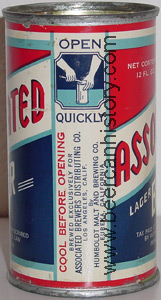 |
"Two-cans-in-one" was coined by Gene DiCicco for this beer can. Gene was given ideas to take the label off, but being an experienced collector and knowing the provenance of the can, Gene preserved it as was found by the Clovis couple. (A slightly short Associated label was obtained with other beer labels by Rawley Douglas BCCA #19952 in a San Francisco antique shop, but later without his permission copies were made; these xerox copies have been seen in collections placed around an unrelated can. Humboldt Malt and Brewing Co had its office at 50 Sutter St and the location of this office may account for the label being found in SF.)) In early 2008 Herman Oswald reported at the Rusty Bunch website that he and another collector opened a "30's" pit in Northern Calif. at a higher elevation campsite. In the pit along with "usual stuff" were found a number of Associated paper label cans with the remains of their paper labels still attached over a "silver primer". When the silver primer was cleaned off, at least 9 "green" Brown Derby cans were revealed - for an unprecedented group of a previously rarely seen beer can label. Herman thinks the campsite pit was of the type used by tourists to the area rather than by local residents. Also for another clue, Herman has described he found, "a couple Coca-Cola soda bottles mixed in with the Brown Derby layer of the pit that had Los Angeles on them, which would indicate possible Southern California tourist influence." When digging, Herman also brings a "Sherlock Holmes" perspective by looking for signs as to the pit's age and who could have been there those many years before. Herman has made many top "finds", but this one could be among the "Top 10" for about any year, and possibly for any of several longer time intervals, decade, etc. The Associated paper label can was first seen in Clovis collection in 1971. At the time, it was thought to be "authentic" since part of a beer can group assembled by a couple who picked up cans as they vacationed around Calif. in the 1930's, but many years were needed until 2008 when other examples were dug from a pit to give more confirmation that it was an "authentic" beer can. Dan Andrews in April/May, 1994 BCCA Magazine has a "Can Close Up" article on the Brown Derby and Associated paper label cans from Humboldt Malt and Brewing Co. Top |
|
|
A is for Aztec Brewing Co. San Diego: (Sept/2011) Per Will Anderson's Beer USA, the Aztec Brewing Company of Mexicali, Mexico in 1932 moved most of its brewing equipment to San Diego in anticipation that the American Prohibition would end. By 1936 it had become the 5th largest brewing company in California after Acme, Rainier, General, and Los Angeles Brewing. |
|
| By 1940 it had canned beer in the five different labels pictured - it's main ABC beer; graphic Old Dutch Beer and Ale, and the rarest can, Associated for a grocery chain. In 1947 Altes Brewing of Michigan made the right decision to include a brewery in a higher growth market and bought Aztec Brewing. However, sales didn't meet expectations and the San Diego brewery location was closed in 1953. Top | ||
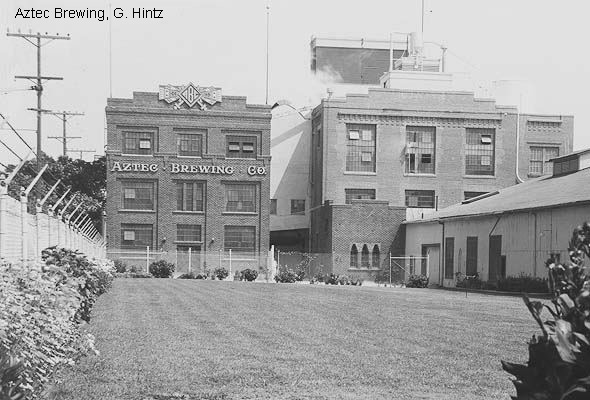 |
||
| B is for Baltimore Breweries: (March/2012) Baltimore, Maryland has a long brewing history with five of its breweries selling their brews in a wide selection of beer, ale, and bock cans starting in 1935. A website, rustycans.com, has over ten Baltimore cans described in its "Beer Can of The Month" section. A very extensive general history site for Baltimore, www.kilduffs.com has included a section "Baltimore Beers", which can be found currently under "Kilduff's A to Z" on first screen; then finding National Brewing, to the right click "beer" to show many past/current pictures of Baltimore's brewery buildings and breweriana. | |
| National Brewing Co. - This brewery became the largest in Baltimore and has a separate listing in ABC's of Cans under "N is for National Brewing" | |
 |
|
The Globe Brewing Co. A few of Globe Brewing's earlier cans are pictured above. Rarer opening direction cans from Globe are Hopfheiser Beer and Eigenbrot's ale. The brewery filled a variety of cans under the Arrow label, and in the 1950-60's ended with Imperial, Hal's and Arrow 77. Below is a picture of the brewery along Hanover St. taken by Ernie Oest in 1953. Arrow Ale was sold per rustycans.com during 1937-38, and apparently (?) was a marketing venture to convey the image as the beverage of choice for those riding as masters and huntsmen during the fox hunts on farms in Maryland and the Delaware/Pennsylvania "Chateau Country". In general the popularity of "Ale" as a malt beverage category has been highest in the New England states. As an example for Arrow Ale, in 2011 around half a dozen Arrow Ale cans in grade 1- and lesser conditions were found during a bathroom remodel in the Boston area. Globe Brewing's venture with this graphic label must not have attracted enough of the brewery's regular customers, as later Arrow cans after the 1930s tended to have less graphic designs. Arrow Ale cans in on-grade condition have been very scarce as well as dumper examples which over the years have been highlights to find. Shamrock Ale, per rustycans.com has been rare with around a case known and "all but one are indoor cans which came from a single find" - that "find" was in the late 1970s and most of the cans were partly to heavily scratched. Eigenbrot's Beer per rustycans.com was distributed in 1935, and the can was very rare until the late 1990s when a clean example was offered on ebay. Then over the next 10 years every so often, another Eigenbrot's Beer was offered on ebay - apparently a "find" of around 10 or more (?) had been uncovered. Arrow Bock with its metallic label has been very scarce in top condition, but scattered examples in grade 1 and lesser conditions have been found. (rustycans.com has extensive background information on Globe Brewing and several of its cans in "Beer can of the month" sections for December, 2004, September, 2009, and April, 2009.) |
|
 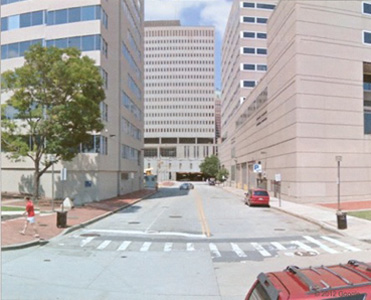 |
|
Gunther Brewing Co. was across the street from National Brewing, and was an early brewery that canned beer with its Gunther's Beer and Ale labels, plus had a large variety of beer, bock, and ale cans after WW II. The Gunther's Beer can shown was bought by a Mid-Western collector, who assembled an extensive collection of cans beginning in the early 1980s. He has said the Gunther's was one of his first rarer cans and was bought in 1981 from Frank Byers, an active can collector/seller at the time. |
|
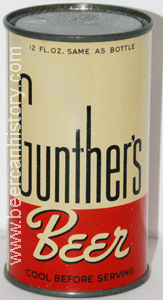 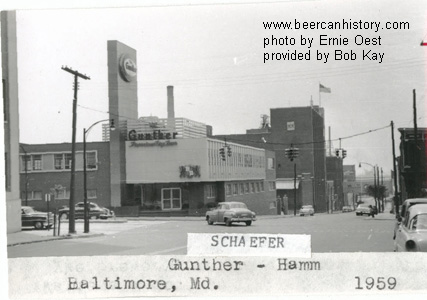 |
(rustycans.com in its "Beer can of the month" section shows a number of Gunther cans in February, 2004, October, 2006 March, 2009, and July 2011.) |
American Brewery, Inc. operated until 1972 in one of the most architecturally interesting brewery buildings in the country, and after being carefully preserved, the building still remains as a landmark for East Baltimore. In contrast to the other larger Baltimore breweries, American only canned beer in one high profile cone and two flat top designs. |
|
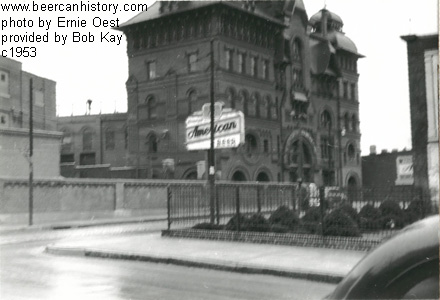 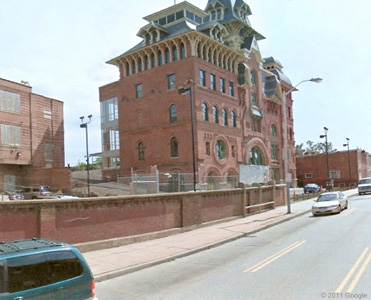 |
|
Free State Brewing was the smallest Baltimore brewery that canned beer, operating until 1949, using a colorful high profile cone with a metallic label. After Free State went out of business, that brewery location became the Wiessner Brewing Company for several years in the early 1950s. (rustycans.com's "Beer can of the Month" in February 2007, described the brewery and showed one of the two Wiessner's cans. ) |
|
| Top | |
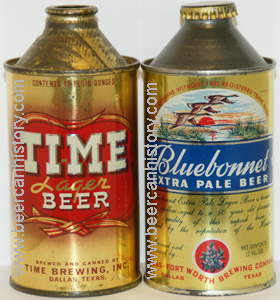 |
B is for Bluebonnet: (Sept/2011) Dallas-Fort Worth Brewing Co. canned Bluebonnet in cones during the late 1940's until around 1952. During the later 1970's a six pack or more were found in top shape of this colorful metallic label, and occasionally other top shape cans have appeared such as one on ebay around 2003 that was held by a St. Louis family after being picked up by a relative during a visit to Dallas long before. During the interval 1938-9 to 1940, the brewery at this location operated as Time Brewing, Inc., canning Time Beer in cones, with a metallic label. Clay Tichelar found a top shape example in the Continental group he bought, and scattered other examples have turned up making the cone relatively scarce. |
| Off-grade examples of both cones are found in moderate numbers to give collectors a range of conditions for these cans with desirable brand names found only in these two cones. Top | |
|
B is for Boston Light Ale: (June/2012) The Boston Beer Company building was located in "South Boston" at 249 W. 2nd St and had been built in the 1880s or earlier. Rustycans.com's Can of the Month for April, 2008 has background on the brewery and a picture of a Boston Light Ale crowntainer. Though the brewery remained in business until 1956, it only canned Boston LIght Ale in a J spout and a quart around the 1940 years; a crowntainer with several variations; and "Stock Ale" in a quart during the 1940s - the labels showing a lighthouse are among the more graphic can designs. |
|
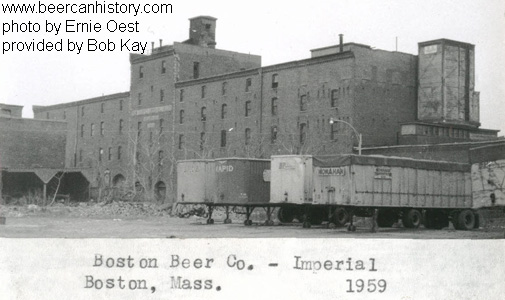 |
Of these cans, the metallic J spout has been the rarest in grade1 and better condition. One of the better cans Ernie Oest had in his collection was a Boston LIght Ale J spout which went to Dave Stark. Dick Caughey said it was mostly grade 1 but had rusty areas along the seam. That can and several other J spout examples in slightly lesser "inside" conditions plus a limited number of dumpers, were the examples known until 2002 when two examples around grade 1+ turned up in one of the oddest coincidences of timing, but apparently the cans were not connected. |
In July, 2002, a J spout example became known to collectors that had been found some years earlier inside an interior wall during renovations of a house in a Boston suburb. Then a few months later, Tom Leo recalls another top shape example was found by a Rochester area antique dealer that was sold to a nearly breweriana collector. Tom doesn't think these two J spouts were from the same source since the antique dealer didn't know anything about the other example that had been sold just a few months earlier. (Except for the same name, the "Boston Beer Company" founded in 1984 with its Samuel Adams and other products apparently has no connection with the earlier, long time brewery in Boston.) Top |
|
| B is for The Brewery-Ana Gazette: Started in late 1971, it is likely the first privately-owned periodical with articles/want ads for buying and selling "breweriana", and was published for a number of years. The December, 1971 BCCA News Report had a notice that BCCA member #32 Howard P. Strohn in San Ardo, California was publishing "monthly" the Brewery-Ana Gazette for: "a collector's exchange with news items and ads of collectors needs." That starting time was around three years before the World Wide Beer Can Collectors publication was started by Robert Dabbs and David Harris in July, 1974 - which later became Beer Cans Monthly. (As background, after starting in 1970, the non-profit groups Beer Can Collectors of America and East Coast Breweriana Asso. had newsletters for members, but the BCCA in particular had the now quaint policy against "buying and selling beer cans" at their events and in their News Report's want ads. Such a policy left a gap for entry of a commercial publication that facilitated buying/selling among dealers and collectors of "breweriana" - The Brewery-Ana Gazette appears to have been the pioneer publication filling that gap.) . Top |
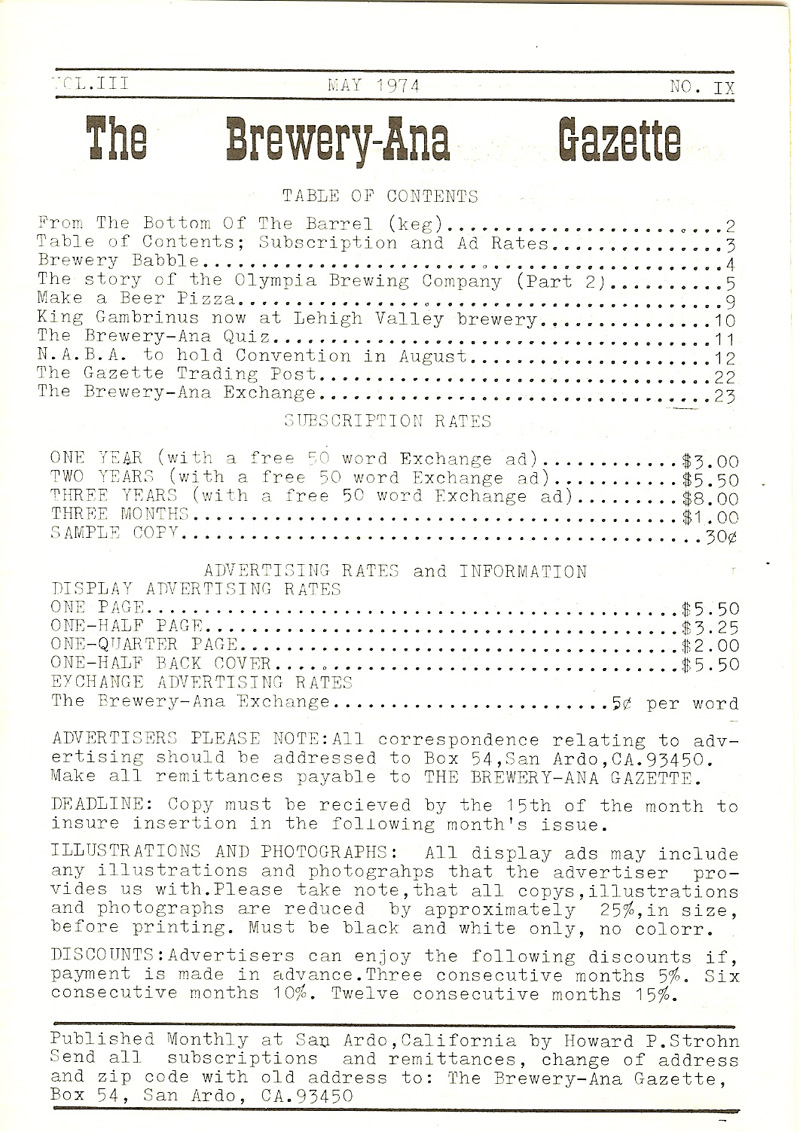 |
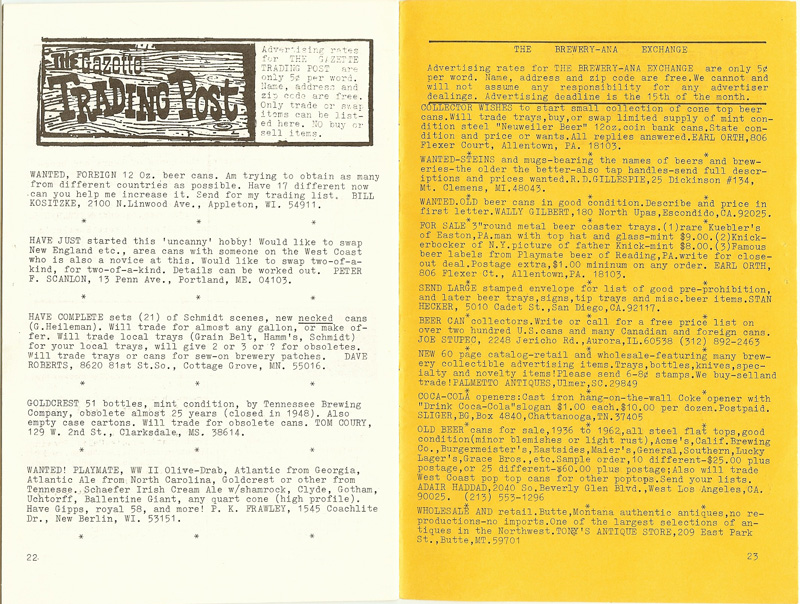 |
| B is for Brockert Porter "J" spout: (Sept/2011) In 1982 an Enterprise Auction featured a Brockert Porter with the claim: "the only known surviving example". However such claims of rarity are risky to believe when a previously unusual can is offered without a long provenance: within a year, Buffalo beer can dealer Paul Michel had located three more Brockert Porter cans held by antique dealer in Lowell, Mass. Two of these cans were top shape and one had a rust mark on the front. Since that time other Brockert Porter cans have been found in dumps but apparently no more on-grade examples have appeared of what still is the only Porter type beer that has been canned. Top | 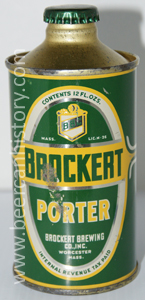 |
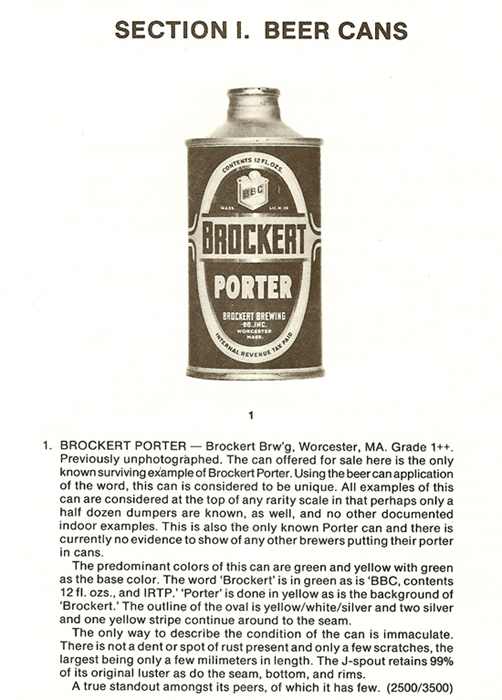 |
|
| B is for Brown Derby: (Sept/2011) The "green" Brown Derby - a variation that apparently had a very short run as few examples are known. Saved early on by a collector who started in 1936 a beer collection at a small Sierra Nevada town and who assembled a 200+ can collection over the next 15 years. Top |
 |
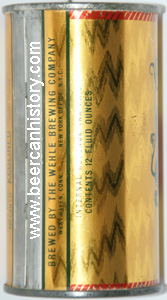 |
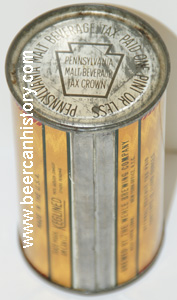 |
B for Buckingham Ale: (Sept/2011) This metallic can has an unusual geometric cross-hatching that makes the can "dazzle"(as described by collector Don Wild) when turned on a light. The two pictures highlight small segments of the cross-hatching, especially in the side view. Two 1+ examples of this brand were in the Pottstown, PA collection and are bottom opened. |
It is uncertain if any more 1+ all-original examples are around, and apparently there are just a few tarnished, to very tarnished/scratched cans also around. Additionally, a Colorado collector has a rolled example that as a flat was first found in the late 1980's by former BCCA member Harvey Lambert, along with some other flats such as Golden Rod. Top
|
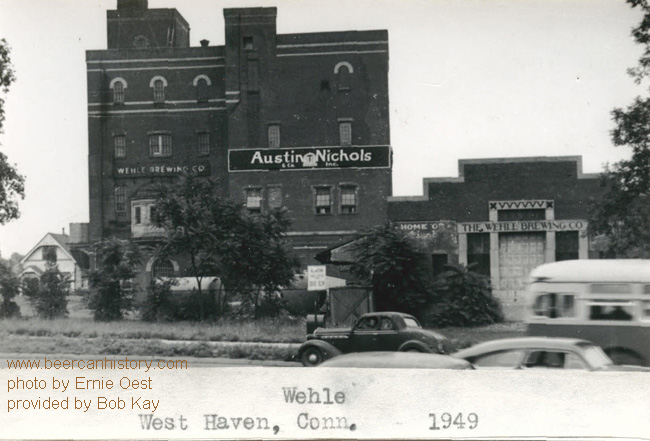 |
||
| B is for Buffalo breweries that canned beer: (Sept/2011) Buffalo had a long brewing tradition before Prohibition, by some estimates, over 80 breweries with around 30 operating at one time during some intervals. Around 1900, Buffalo was one of the country's major industrial centers as the 3rd largest steel producer, a major grain terminus for the Great Lakes, and was an active transportation hub with a substantial German and Polish population who liked drinking beer. | |
For a U.S. city with a population around 260,000 in the 2010 census, Buffalo has among the widest variety of architecturally significant civic/residential structures still in use and has an active Preservationist movement. There is a well organized and extensive website of current photos, historical backgrounds, etc.: "Buffalo as an Architectural Museum". Unfortunately in one industrial category, Pre Pro brewery structures, not many are left but the exterior of a good example does remain - part of the original Ziegele/Phoenix Brewery (1888) at Washington and Virginia. This former brewery's exterior walls, well represent a typical design by Otto Wolf of Philadelphia with elaborate brick work, etc.
|
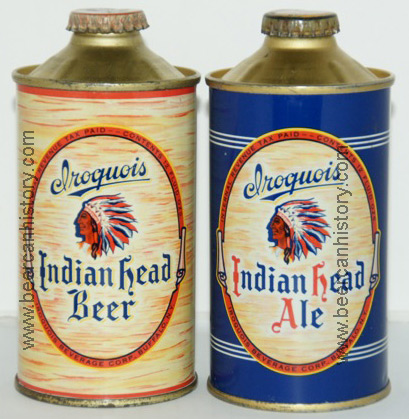 |
After Prohibition the main breweries that returned to making beer were: ----Gerhard Lang Brewery (the largest in Buffalo before Prohibition, once covering over 30 acres at Best and Jefferson) which lasted until 1949. and five breweries in East Buffalo, south of Broadway: ----Magnus Beck Brewing Co. which lasted until 1955. ----Phoenix Brewery, which after Prohibition had relocated to the former "East Buffalo Brewery" building, canned beer briefly in the late 1950's before being bought by International Breweries in 1959; which then reportedly used the plant to brew ale briefly. ----Iroquois Beverage Corp., which in 1955 became the lead brewery of five breweries in several states that joined to become International Breweries, Inc. The Pratt St. brewery in Buffalo was a functional 1890's design that operated until 1971, and still has several buildings standing. ----The William Simon Brewery, farther south on Emslie from Phoenix Brewery, canned beer from the 1950's into the later 1960's. The Brewery, lasting until 1972, operated in a better-than-average architecturally detailed 1900-era building that is still standing ----George F. Stein Brewery, which stopped in 1958, had its brewery building demolished in 1959. The Stein location at 797 Broadway, had been the site of a brewery since 1852. (In the 1920's, part of the former brewery land was taken to realign Smith St. at the intersection with Broadway to match with Herman St. going north. Beer cans: ----During the 1930's Iroquois Beverage canned Iroquois Beer and Ale in two graphic low profile cones, along with an olive drab J-spout during WWII. The U. S. Beer Cans picture of an Iroquois Half and Half "cone" has been described by New York collector Tom Leo as, "a partial Half and Half sheet that has been rolled." For some years a BCCA collector, William Breen, knew about an "all original" Iroquois Half and Half cone that was held by a former Iroquois employee; got the cone; and in 2011 passed it to a dealer. As of 2011, there is uncertainty, if and how many, dumper examples of the Iroquois Half and Half cone have been found. After World War II, Iroquois filled a variety of high profile cones and crowntainers. When International Breweries was formed in 1954, four of the breweries began canning beer in a flat top label that has been called "The TV Screen" design for a number of brands (Iroquois, Silver Bar, Frankenmuth, Old Dutch). Also several local brands were canned with their own labels. ----The William Simon Brewery canned beer in the 1950's and 1960's with its "Simon Pure" label. ----The George F. Stein Brewery started canning in the early 1950's and filled six colorful beer and ale cans with the rarest being the early 1950's "Canadian Brand Cream Ale" that has a picture of that brand in a bottle by the seam. In the 1950's and 1960's the Buffalo area saw the importation of many Canadian beers and ales ("dumped" into the Buffalo market?), which was another challenge for Buffalo breweries. Still to be uncovered is whether the Stein Brewery marketed its "Canadian Ale" to sell in Canada or to give Buffalo ale drinkers a "Canadian style" ale that was produced in Buffalo as an alternative to the Canadian imports. The USBC book shows an example of the Canadian Brand Cream Ale flat top. Tom Leo understands Paul Michel got that Stein's Canadian Ale can from a Buffalo collector. In the Class Book there is also a picture of the Stein's Canadian Ale example but the can's colors look much brighter than the USBC example and uncertain if there is just one or at least two examples. (Paul Michel was one of the most active 1980's beer can dealers and was located in Buffalo, until he unfortunately died in the later 1980's. While Paul's father was a coin dealer and Paul grew up knowing all the "dealer angles", he was known to convey many rarer cans to on-going collectors at prices that encouraged their continuing buying, rather than pricing a can for only the one buyer who might appear.) Top |
|
| B is for Butte Beer low profile: (Sept/2011) The brewery in Montana filled two different cones and several flat tops until going out of business in the early 1960's, with the 1930's low profile was the rarest. Clay Tichelar found a Butte low profile cone in the Bensenville, IL collection and for some years it was thought to be the only example available. However, by the late '70's, collectors in Montana had heard about a small find held originally by a former employee. Per Jack Riesselman, around 1983-4 a Montana antique dealer turned out to have 17 of the low profiles and sold some to him, Ole Olsen, and a few other collectors. In the 1990's Jack saw another low profile at a Butte show that wasn't part of the original "17", which makes "19" on grade examples, so far. |  |
Also Jack knows of at least two flat sheets that have been made into cones, and has seen two dumpers. The Butte low profile continues as a rare can with less than a case of on-grade examples and unusually for a rare cone, as of summer, 2009 apparently there are more on-grade examples than dumpers. Some collectors have copies of correspondence on Butte Brewing Co. letterhead from late 1936 that discusses sending "6 cases" to one distributor, and more were likely shipped. In Montana cabin or campsite pits from the '30's, more Butte low profile cones are awaiting discovery. Top |
|
 |
C is for Clipper Beer by Grace: (Sept/2011) In the late 1930's, one of Grace Bros. more colorful brands pictured a Clipper airplane that recently had started commercial flying across the Pacific. Today at Treasure Island in San Franciso Bay, there is still "Clipper Cove" where these airplanes would float before or after their flights. Clipper flat top beer cans were first found in volume (an estimated 50 or more) by Wally Gilbert under the Wagon Wheel Bar in 1972, but these cans were typically "under the house" condition cans with the best being grade 1-. However, a much later 2002 attic "find" in West Sacramento had around 13 Clipper cans, one of which is pictured above. However most of these cans, while being rust free, were deeply dented and subsequently have been repaired with a lid replaced. The story on this "find" was described in the April, 2003 BCCA magazine article that included Gene DiCicco's picture with most of the cans from this group. |
| Clipper beer cans were produced by Grace Bros. at its breweries in Santa Rosa and Los Angeles. Outside the above two "finds", other Clipper cans in 1/1+ condition have been relatively scarce and the label is one of the most graphic cans for collectors. Top | |
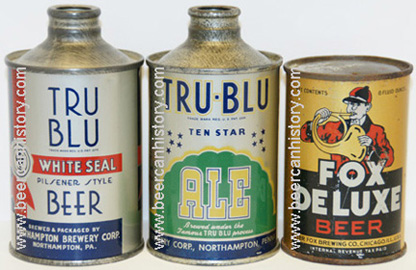 |
C is for Crown Can's small-sized cans: (Sept/2011) Around 1940, American Can Company and Continental Can dominated the U.S. beer can producing industry, followed by National Can and the newest entry, Crown Cork & Seal of Baltimore, Maryland. Crown Cork & Seal had originally been founded in 1892 to make bottle crowns, and by the 1930's had over half of the world market for crowns. Importantly, early-on the company established extensive operations overseas, which later turned out to be an important driver of its sales growth into a major can producer. In 1936 Crown Cork & Seal bought the Acme Can Co. of Philadelphia and began producing food and beer cans under the name "Crown Can". |
| As of 2011, of the four U.S. can manufacturing companies in the 1930's, only Crown Cork and Seal (now named Crown Holdings, Inc.) has continued as the same corporation and one which still manufacturers a variety of packaging products, largely due to the leadership of John Connelly and William Avery. In 1957 John Connelly became President when the company was on the brink of bankruptcy. He focused on cutting costs; producing a range of packaging containers, such as beer cans, aerosol cans, etc.; moved the Company's headquarters to Philadelphia in 1958; and emphasized its already strong positions in overseas markets. |
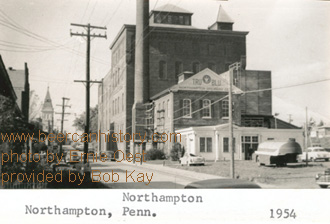 |
| In the late 1980's, management leadership next passed to William Avery who continued to focus the company on the packaging industry, rather than diversifying into other areas. However, he did start actively acquiring other companies with packaging operations, such as the activities of Continental Can during the years around 1990. By the 1980's American Can's management, faced with new competitive pressures in the packaging business, had tried diversifying into financial services; sold its packaging business in 1986; and changed its name. The American Can packaging operations was merged with National Can, and after several owners, is now owned by a British global packaging company. Crown Can's beer cans: As Crown Cork and Seal grew after WWII, the production of beer cans were only one of the many types of packaging sold by the company that enabled it to survive in the 1950's and fueled its growth in following decades. For beer can collectors, Crown Cork & Seal's beer cans from the later 1930's are among the most graphic and collectible of all beer cans. These cans were typically characterized by high quality printing of colorful/intricate label designs - often modeled on a brewery's paper labels for bottles. Additionally, since most of Crown Can's beer cans were sold to medium and small-sized breweries, these 1930's era cans remain generally scarce for collectors to find. Compared with American Can and Continental can, Crown Cork & Seal in the 1930's produced the widest variety of cans types and sizes from quarts; its variation of the "low profile" cone top, called by collectors "J spout"; standard-sized 12oz flat top cans; a few brands in the "tall" 12oz flat top cans, Frederick's, Ambrosia, etc.; its "Crowntainer" that was patented in 1937; and small-sized cans that are pictured above, two 10oz "J spouts", and a "tall" 8oz flat top can. (The beer can collectors term, "J spout" was first used by Dave Peck in the mid 1970's - see C is for Cremo Brewing. Among Crown Cork & Seal's earliest flat top beer cans apparently were a number of brands made for Monarch Brewing Co. of Los Angeles since some of those cans have "Crown Can" on them. Given Monarch's location across the country from Crown's Philadelphia plant, the background on how Crown Cork & Seal gained such a contract, and if it did, awaits more verification.) In the late 1930's Crown Cork & Seal made two 10oz. "J spout" cans, for Northampton Brewing, in Northampton, Penn. - Tru Blu Beer and Tru Blu Ale; and for Peter Fox Brewing in Chicago, the "tall" 8oz Fox Deluxe flat top can. On grade examples of these three small-sized cans are very scarce, and though several dozen dumper examples, or more, have found over the years, these small-sized cans from Crown remain "highlight" cans whenever found by collectors. The Northampton Brewery building pictured above (the exterior still looks approximately the same as of 2010), was taken by Ernie Oest - one of many photos of brewery buildings Ernie took from the 1940's to 1960's. (picture provided by Bob Kay.) Top |
|
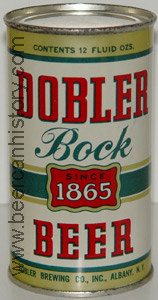 |
D is for Dobler Bock: (Sept/2011) A bottom opened example from the collection of Joe Veselsky and a can he said he picked up in the mid 1950's while on a drive from Long Island to Niagara Falls. Top |
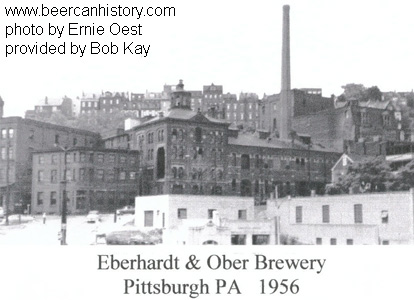 |
D is for Dutch Club: (Sept/2011) These two cone variations were of a brand connected with "Eberhardt & Ober Brewing Co", part of Pittsburgh Brewing Company. Details are in the August, 2003 BCCA magazine article, but in 1899 Pittsburgh Brewing Company led one of the larger mergers of local breweries which combined to make, at the time, the 3rd largest brewing company in the U.S. Top | 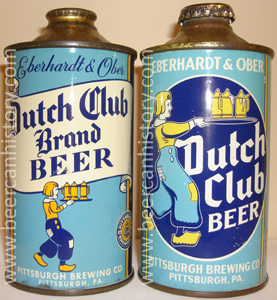 |
| [Back to Home] | |
| Copyright © 2007-2016 www.beercanhistory.com, All Rights Reserved. Last modified January 16, 2016. | |